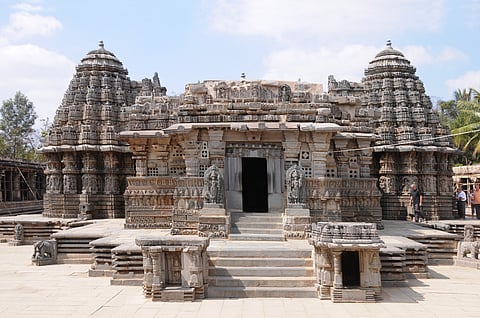
- Destinations
- Experiences
- Stay
- What's new
- Celebrating People
- Responsible Tourism
- CampaignsCampaigns
- SubscribeSubscribe
- Buy Now

The Hoysala temples of Karnataka, that were among the list of contenders for the UNESCO World Heritage Site 2023 are now they are officially part of the list. The running list of world heritage sites was announced by UNESCO on Monday and includes another Indian site, Santiniketan in West Bengal. Besides these architectural marvels from India, the list also features the Gaya Tumuli burial mounds from South Korea; Erfurt's medieval Jewish legacy, Germany; Takalik Abaj ruins, Guatemala; Bale Mountains National Park, Ethiopia among others.
The Hoysala temples of Karnataka are a magnificent testament to the architectural and artistic prowess of the Hoysala dynasty, which ruled over the Deccan region in Southern India from the 10th to the 14th century. These temples, known for their intricate and ornate style, are scattered across the modern-day state of Karnataka, with their most notable concentration in regions like Belur, Halebidu, and Somnathapura.
The Hoysala dynasty, founded by King Nripa Kama in the 10th century, rose to prominence during a time when southern India was experiencing a cultural renaissance. Their rule marked a period of significant cultural and artistic development, with a particular focus on temple construction and patronage of the arts. The Hoysalas' architectural achievements, especially their temples, reflect a blend of various South Indian architectural traditions and their distinctive style, which set them apart.
What sets the Hoysala temples apart is their stunning architecture, characterised by intricate stone carvings and sculptures depicting mythological stories, deities, animals, and scenes from daily life. The temples typically follow a star-shaped plan known as "vimana," which features multiple shrines, intricate towers, and an open-pillared hall called "mandapa." A cuboid chamber known as the "garbha griha" or sanctum sanctorum serves as the temple's core, housing a sacred icon centrally positioned on a pedestal called the "pitha." Rising above the garbha griha is the majestic "shikhara," which, when combined with the sanctum, forms the temple's central structure, known as the "vimana" or "mulaprasada." Crowning the shikhara is a ribbed stone known as the "amalaka," adorned with a finial called the "kalash."
Connecting the garbha griha to the front is an intermediary space known as the "antarala," which leads to an expansive porch adorned with pillars, commonly facing the east or north. The temple is typically accessed through entrances embellished with towering and ornate entrance towers known as "gopurams." Within the temple courtyard, known as the "prakaram," one often encounters smaller shrines and auxiliary structures. These elements collectively contribute to the grandeur and architectural splendour of the temple complex.
The Chennakesava Temple at Belur, constructed by King Vishnuvardhana in the 12th century, is one of the most iconic Hoysala temples. Its intricate detailing and exquisite craftsmanship showcase the Hoysala's dedication to art and architecture. The Hoysaleswara Temple at Halebidu, built during the rule of King Vishnuvardhana's grandson, King Ballala II, is another stunning example of Hoysala architecture, with its sculpted walls and intricately carved pillars.
The legacy of the Hoysala temples extends beyond their architectural marvels. They played a vital role in the preservation of Indian art, culture, and religion. The temples were not merely places of worship but also learning and cultural exchange centres. The Hoysala dynasty's patronage of art and culture left an indelible mark on the Deccan region's heritage.
Today, these temples continue to draw visitors and scholars worldwide, offering a glimpse into a glorious chapter of India's history. They are revered for their religious significance and celebrated as architectural wonders, contributing to Karnataka's rich cultural heritage.
Places To Visit Nearby
While visiting the Hoysala temples, exploring the diverse attractions in the surrounding areas is worthwhile. Begin with the temple towns themselves, Belur and Halebidu, to immerse yourself in the exquisite Hoysala architecture. Venture to Shravanabelagola to witness the colossal monolithic statue of Lord Bahubali, a marvel of Jain heritage. Though slightly further away, Mysore offers a regal experience with its grand Mysore Palace and cultural richness. Chikmagalur beckons nature enthusiasts with its lush landscapes and coffee plantations, providing opportunities for trekking and wildlife exploration. You can delve into historical forts and temples beyond the Hoysala gems in Hassan. Sringeri, on the banks of the Tunga River, showcases the region's spiritual side with the Sringeri Sharada Peetham.
Where To Stay
Hassan serves as a convenient hub for temple enthusiasts, boasting a variety of accommodations to suit different budgets. Luxurious options like the Hoysala Village Resort and The Ashhok Hassan provide a comfortable retreat. At the same time, mid-range choices such as Mallige Residency and Suvarna Regency offer quality amenities without breaking the bank. Travellers on a budget can opt for Hotel Mayura International or Hotel Raama.
Belur and Halebidu, home to some of the most exquisite Hoysala temples, also offer lodging options. Hotel Mayura Velapuri Belur and Hoysala Village Resort (in Hassan) are good choices for those exploring Belur and Halebidu. Additionally, if you wish to combine your temple visit with the scenic beauty of the Western Ghats, consider staying in Chikmagalur, where The Serai, Java Rain Resort, and other accommodations cater to various budgets.
Getting There
To reach this UNESCO World Heritage Site in Karnataka, start by flying into cities like Bengaluru or Mysuru. From there, plan an itinerary covering Belur, Halebidu, and Somanathapura. Travel by road, renting a vehicle or using public transportation like buses to reach these temple towns. Belur and Halebidu are close, while Somanathapura requires a transfer from Mandya.
